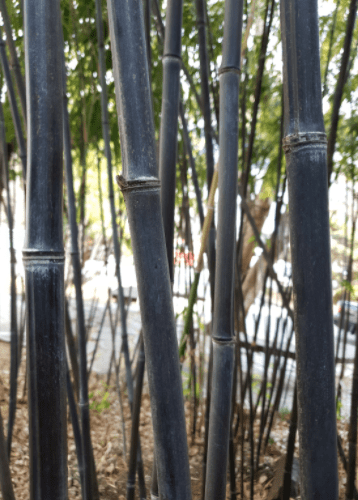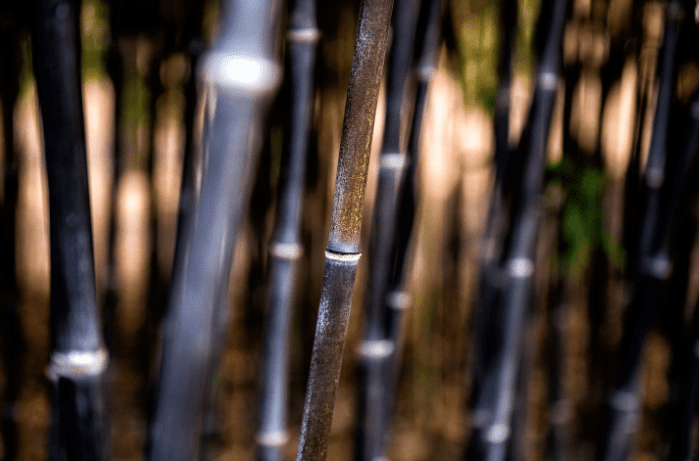Bamboo Information
The Oriental Black Bamboo (Phyllostachys Nigra) is an extremely fashionable feature plant and must be for any prestigious garden design.
The combination of black and sly green is astonishing and will help create a striking yet tranquil garden atmosphere without being invasive.
Black bamboo stems are the perfect complement for that Asian-inspired garden you’ve always wanted. All of the canes on this fantastic architectural plant are black, contrasting beautifully with the bright green leaves.
It’s time we find Phyllostachys nigra for transforming rooms since it’s dramatic day and night against the planes of modern architecture and colorful walls.
Black bamboo is not a tropical plant despite its popularity in Los Angeles. It’s a temperate species that can withstand cold temperatures in zones 7-8. At 5 degrees Fahrenheit, frost damage can be considerable.
Phyllostachys nigra was introduced relatively late, but it became popular in Southern California throughout the early twentieth century, alongside its formerly famous but invasive twin, Phyllostachys aurea.
Both became epidemics as they spread rapidly into monstrous thickets by runners who grow so quickly that some people claim they can hear them. Often used as privacy hedges, this invasiveness spreads too quickly under fence lines, invading neighbors.
If you treat black bamboo properly, it won’t become invasive. Over the last few decades, people have experimented with numerous bamboo root control technologies to keep the clump clean and architectural. The bamboo inside the 5-gallon nursery container acts as a poor man’s root guard, preventing horizontal root growth.
Phyllostachys nigra is a beautiful container plant, mainly when grown in huge Asian-style pots. When used in beds or on patios, landscape pots can create a lovely plant that is entirely free of the risk of invasiveness.

The bamboo is also raised higher in the pots, bringing those lovely ebony stems right up to eye level. Make sure the pot has a broad mouth so you may plant a large specimen for quick results and easier watering. Pots let you display your Asian home décor on a balcony, rooftop, or anyplace else in direct sunlight.
How you shape your plant is the true key to making a beautiful nigra specimen. They are large and bushy in the nursery and are used as screening material. In Asia, the bamboo is trimmed so that only the lower half of the canes are visible, with the leaves remaining on top.
They’ll leave a few twigs and leaves on the canes at random intervals to get a perfect balance. With this method, anyone can prune that black bamboo bush into their masterpiece.
Culms that sprout from the root of the bamboo develop new shoots. This is why bamboo prefers a wide-mouth pot with plenty of room for new stems to emerge beneath the surface. The shoots are edible when fresh and green and are popular in Asian households.
The unbroken culms actually telescope as they expand into longer and longer segments.
The green cane darkens with solar exposure as it reaches maturity, taking up to two years to acquire its ebony shade. Cycle out the oldest canes before they lose their color and bring them inside for accent arrangements, crafts, or staking tropicals over time.
How To Care For Black Bamboo
Bamboo is grass; therefore, it prefers the same things your lawn does: water and nitrogen. No need to fertilize the plants until they’re a little older.
Keep plants on the drier side to limit growth; supply even moisture for rapid growth. Avoid watering the black stems to avoid residue if you have hard water.
Phyllostachys nigra can be found in garden centers, home improvement stores, and the internet. Prepare to place a bespoke order for the best specimen and root ball to fit into the large pot you adore.
Bamboo can withstand strong gusts without breaking, only to return to its original position once the storm has passed.
As a result, it has become a crucial Asian metaphor for bouncing back from life’s storms. There is no better plant in your outdoor spaces, gardens, and landscapes to signal your life, mind, and spirit shift.
Bamboos are unrivaled when it comes to impact on plants. They may grow 4 feet in a day, hide a neighbor’s looming two-story house in a few years, or transform a typical backyard into an exotic refuge in a matter of years.
True, some out-of-control plants, such as golden bamboo (Phyllostachys aurea), shoot out runners into every corner of the yard and beyond, giving the bamboo family a poor rep.
However, thanks to a few dedicated collectors and specialty nurseries who have brought species from Africa, Asia, Australia, and South America, the number of garden-worthy species has continued to grow.
More than 1,000 species of true grasses, native to tropical and temperate rain forests as well as dry chaparrals, make up this complex group. Short groundcovers to 55-foot-tall giants are among the plants on display.
Others grow in beautiful, arching clusters, while others grow in tight, upright clumps. Others put up widely separated stems (also known as culms) that generate open groves that can be explored.
Leaves can be short and cluster around the nodes—the ringlike joints along the stems—like fluttering butterflies, or they can grow to be more than a foot long.
Bamboo may be grown in practically any Western environment. Some are quite hardy (to -15° or -20°F), whereas others are destroyed by temperatures above 20°F. Shade-loving varieties thrive in nature as understory plants, while others thrive in the broad sun.
Dumpers make dramatic focal points, and running bamboos can produce magnificent groves. Choose the perfect bamboo for your garden with the help of the recommendations on page 116.
Bamboo should be planted in fertile, well-drained soil. Deep and regular watering (when the soil is slightly damp to the touch about 4 inches under the soil surface). Apply a high-nitrogen fertilizer two to three times a year, according to package guidelines, between spring and fall.
Any lawn fertilizer will suffice (such as a 16-6-8 formulation). Once the plants are fully established, trim out some old stems to create open groves. Each spring, cut away the thinnest, weakest new shoots to create the largest stems on mature plants.
Are you a runner or a clumper?
Clumping bamboos have short roots, and their clumps only grow a few inches per year. The rhizomes (underground stems) of running bamboos migrate sideways in the top 2 to 18 inches of soil, with some types straying hundreds of feet from the mother plant.
Running bamboos are great for long screens, hedges, or groves since they fill in swiftly. The majority of them can withstand freezing temperatures. Otherwise, the plants will take over your yard unless you use barriers.
Use flexible polyethylene barriers 30 to 40 millimeters thick (60 mil for very aggressive varieties) and 22 to 28 inches deep. Install the barrier around the planting perimeter, leaving a 3-inch lip protruding above ground; overlap and clip the ends together with a fastener or polyethylene-compatible glue.
Cut off rhizomes that “leap” over the barrier’s exposed top.
Bamboos that clump together create great focal pieces or beautiful little screens. These plants require a 3 to 10-foot diameter area to develop completely; however, they do not require root barriers.
Bamboos of the highest quality
FOR OUT IN THE WOODS
Phyllostachys Viridis ‘Robert Young’ is a kind of Phyllostachys Viridis. The stems are bright yellow with a few green streaks. Stems are 3 inches wide and 40 feet tall—Hardy to -5°F in full sun.
P. vivax is a species of vivax—giant bamboo with smooth, bright green stems that grows quickly. Stems are 4 inches wide and grow up to 50 feet tall. The temperature is -5 degrees in the full sun.
SUITABLE FOR SMALL TREES
Black bamboo (Phyllostachys nigra) (Phyllostachys nigra). In the second year, the stems turn black. It’s best in the shade and a fantastic container plant. Stems are 12 inches broad and grow to be 15-20 feet tall—0 °; full sun (grows slowly in the shadow). Leopard-skin bamboo (P. n. ‘Bory’) can reach 50 feet.
FOR HEDGES OR SCREENS
Bamboo with a golden hue (Phyllostachys aurea). Bamboo is both fierce and attractive. Only use it in containers, planters (as pictured on page 114), or in the ground with a robust root barrier. 2 in. broad stems; 15-25 ft. tall The temperature is 0° in the full sun.
Phyllostachys rubromarginato is a species of Phyllostachys. The wood produced by green stems is of high grade. 3 12 in. wide stems; 55 ft. tall. -15°; full sun (ideal for hot areas).
Bamboo from the temple (Semiarundinaria fastuosa). Olive green stems on a narrow, erect, slow runner (faster in warm, mild areas). Stems are 12 inches wide and 20-30 feet tall. -5° with full to partial sun.
POINTS OF INTEREST
Phyllostachys aureosulcata spectahilis is a species of Phyllostachys aureosulcata. Green streaks in the grooves of bright yellow stems; looks excellent with P. a. ‘Yellow Groove.’ 2 in. broad stems; 15-25 ft. tall The temperature is -10° in the full sun.
‘Yellow Groove,’ P. a. Green stems with bright yellow stripes running between the grooves. 2 in. broad stems; 15-25 ft. tall The temperature is -10° in the full sun.
Clumpers
IN THE CASE OF SCREENS
‘Alphonse Karr’ multiplex in Bamhuso. Gold canes with green stripes, with a reddish hue on the newer ones. Stems are 12 inches wide and up to 20 inches tall. The temperature is 18 degrees in the full sun.
Weeping bamboo from Mexico (Otatea acuminata aztecorum). Lovely lacey foliage. Stems are 12 inches wide and grow up to 20 feet tall. Temperatures range from 20 to 22 degrees in the full sun.
Bamboo umbrella (Fargesia murieliae). Plant with green stalks that weeps. 12 in. wide stems; 15 ft. tall. -20° in the shade. Fountain bamboo (F. nitida) grows to a height of 12 feet.
POINTS OF INTEREST
Bamboo in a blue hue (Himalayacalamus hookerianus). The stems are powdery blue with dark purple rings. Stems are 34 inches wide and grow up to 20 feet tall. 15°-25°; partial shade or morning sun.
Straight bamboo from Chile (Chusquea culeou). Lime green stems and dark green nodes characterize these feathery clusters. Stems are 1 inch wide and grow up to 20 feet tall. The temperature is 0° in the full sun.
Other Black Bamboo Varieties
- running black bamboo
- Timor black bamboo
- dwarf black bamboo
- giant black bamboo
black bamboo for sale on Amazon























